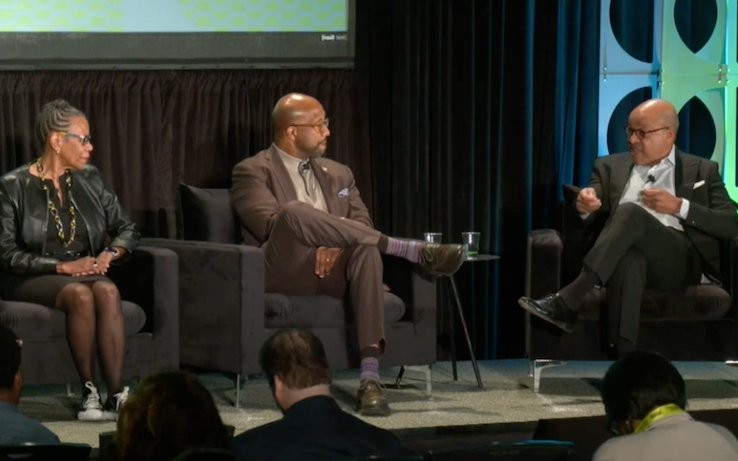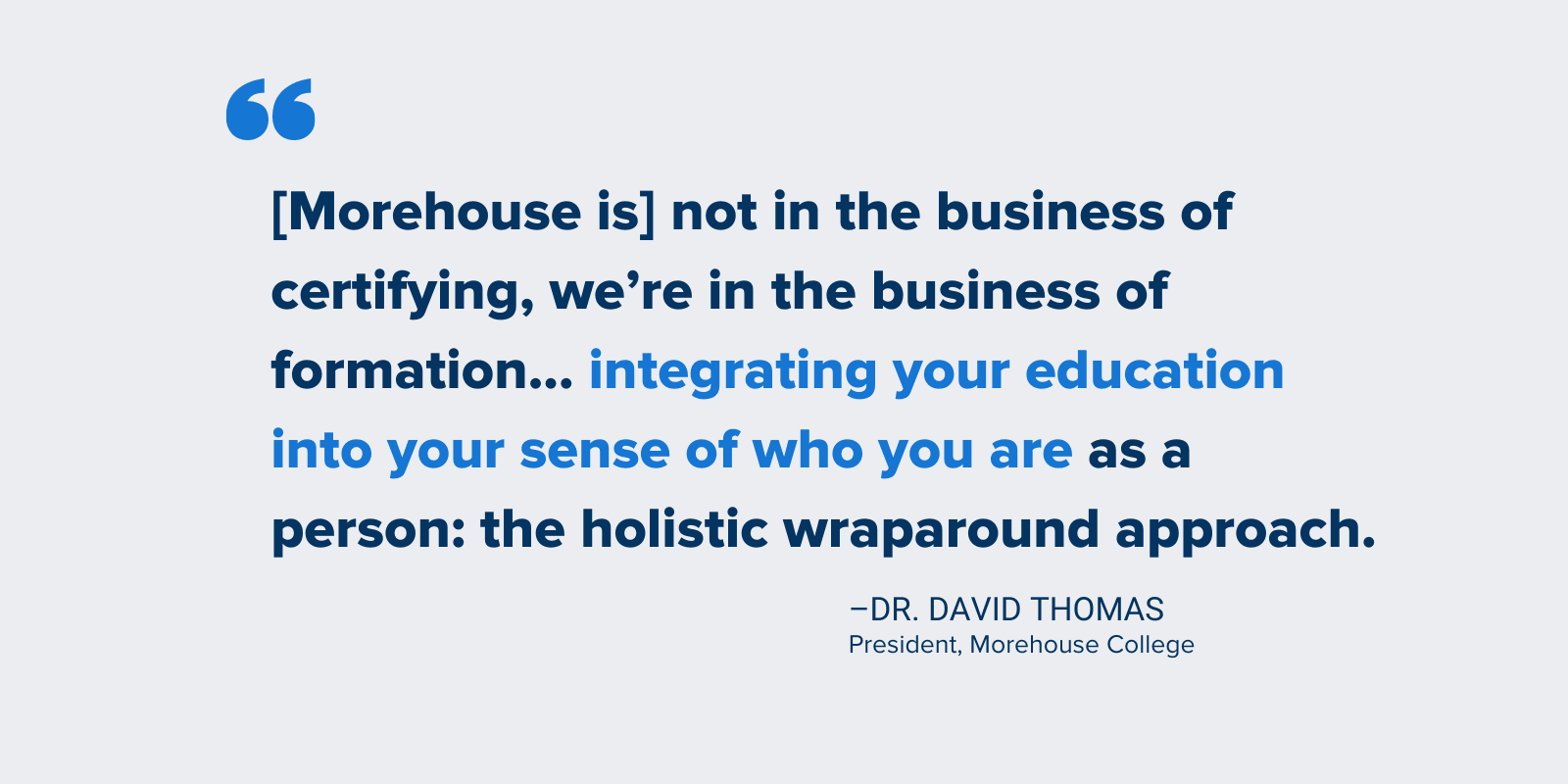Insights
4 Considerations from HBCU Presidents Carving New Education-to-Career Pathways
Written by Maya Evans on Mar 21, 2022
Related content: Diversity And Inclusion, Undergraduate Programs, Thought Leadership

Since their inception, our nation’s Historically Black Colleges and Universities (HBCUs) have been unafraid to embrace change. Tide-turning moments in the civil rights movement, including the Greensboro sit-ins and the Freedom Rides, were sparked by HBCU students and alumni. Even the goal these institutions were founded on was once radical: providing Black Americans access to higher education when historically white institutions refused.
Now, as we hopefully begin to enter a post-pandemic economy, HBCUs continue to chart a visionary path forward for higher education and our nation at large. Last year, the distinguished, Atlanta-based HBCU Morehouse College launched a fully online bachelor’s degree completion program in partnership with 2U. The program caters to Black men who have completed some college in the past but never received a degree. Other HBCUs, including Spelman College in Atlanta and Paul Quinn College in Dallas, have also launched similarly innovative programs for both traditional and non-traditional students.
On March 7, the presidents of these three esteemed institutions—Dr. David Thomas of Morehouse, Dr. Mary Schmidt Campbell of Spelman, and Dr. Michael Sorrell of Paul Quinn—convened for SXSW EDU to discuss new education-to-career pathways. In a conversation moderated by USA Today’s Chris Quintana, they shared the following four takeaways on the role HBCUs can play in preparing students for the future.
1. HBCUs are powerful and attractive because they’re providing long-awaited opportunities for non-traditional learners.
After the onset of the pandemic, enrollment dropped by over 6% across the higher education sector. But many HBCUs witnessed the opposite trend: renewed interest in their offerings. Morehouse, for one, admitted its largest class ever in 2021. Dr. Thomas attributes this uptick to the nation’s racial reckoning after the death of George Floyd, as well as the launch of the Morehouse Online program.
Many of the program’s participants, who range in age from 27 to 72, have already achieved successful careers, but are still looking to complete their undergraduate education. Within 72 hours of announcing the globally accessible program, Morehouse Online received over 5,000 inquiries, confirming the immense appetite for such an opportunity.
“There are 3.4 million Black men in America with some college credit but no degree,” said Dr. Thomas. “They understand both the economic value of completing a degree and also feel, in some way, that completing a degree is about completing themselves. I also think there is a shift going on in the population that essentially says ‘young people should go to the place that best fits them,’ and the idea that [predominantly Black institutions] are inferior has dissipated in our communities.”
2. Community is an integral part of the HBCU experience that transcends a physical campus.
From Homecoming to graduation, HBCUs create a strong sense of belonging that can’t be rivaled. Skeptical that this could exist through an online format, many were resistant to Morehouse’s and Spelman’s online programs at first, but the colleges ultimately found a way to migrate key aspects of their undergraduate experiences online.
For example, Morehouse integrated its Crown Forum ritual, which students attend in-person every Thursday, into its online program. Dr. Thomas has found that the conversations taking place in online classes are no less rooted in commonality than they would be in an on-campus Morehouse class, thanks to its faculty’s experience in facilitating such discussions and the expectations students are bringing about what it means to be online at Morehouse.
“We’re not in the business of certifying, we’re in the business of formation,” said Dr. Thomas. “Formation is about integrating your education into your sense of who you are as a person: the holistic wraparound approach. We’ve been positively surprised at how much of the Morehouse community has been created online because of what these students are bringing to the table and to that experience.”
Spelman and Paul Quinn experienced similar resistance, but Dr. Sorrell pointed out that the transition to online teaching has been long overdue. The pandemic ultimately forced higher education to catch up to the rest of society.
“Everyone else had figured out how to create strong, connective communities online to deliver substantial and meaningful relationships,” he said. “People are getting married based on just engaging online—and we can’t teach online? It forced us to call BS, because it was BS. It was because people didn’t want to do it. It offended their notion of what [education] has always been.”

3. HBCUs must undertake partnerships with purpose and an emphasis on sustainability.
With renewed efforts to hire diverse talent, many companies are looking to recruit from HBCUs, which continue to produce an outsized number of Black professionals. However, Dr. Thomas, Dr. Campell, and Dr. Sorrell stressed the importance of ensuring these partnerships are genuine and sustainable over the long term, not a “transactional drive-by,” as Dr. Thomas noted.
“One of our strategic pillars is ‘partnerships of purpose,’ and that guides us in how we think about which companies, people, and organizations we will develop close relationships with. [We strive to partner with] institutions who want mutual benefit, not charity going one way,” he said. “Part of demonstrating that comes back to this notion of investing in our capacity, so that we become sustainable over time.”
Guild Education is one such partnership of purpose. Through Guild, Morehouse, Spelman, and Paul Quinn help corporations create programs to educate and upskill their employees. Participating companies include large retailers like Target and Walmart, which employ a disproportionate percentage of the Black workforce.
“Many individuals who are coming out of school and have to support their families, who otherwise might end up at a Morehouse or Spelman, go to a Walmart or Target,” said Dr. Thomas. “Now they’re store managers, and Target sees the need to invest in that human capital—not just to give them a skill, but to make them critical thinkers and problem solvers.”
4. An HBCU education centers around affordability, accessibility, and lifelong learning.
With more attention for HBCUs has come much-needed financial support. The CARES Act, passed in March 2020, gave $1 billion to HBCUs and other Minority Serving Institutions (MSIs), many of which have been using the funds to relieve debt and improve living and learning facilities. Congress has also discussed potentially doubling the maximum award amount of the Pell Grant, which would be a significant milestone for HBCUs whose student bodies tend to be majority Pell-eligible.
In addition to thinking about affordability, Dr. Campbell, Dr. Thomas, and Dr. Sorrel have given ample consideration to the long-term relevance of their institutions. This means creating programs that expand the traditional notions of when and how people can receive an education. “This notion that learning only takes place between ages 18 and 24 is a fiction,” said Dr. Campbell.
Dr. Thomas agrees that our concept of learning must become more fluid in order to adapt to our changing world. “The reality is that 50% of the jobs that exist today will not exist by 2050,” he said. “We cannot today see the jobs that will replace those jobs, so we’ve got to be in the business of lifelong learning and evolving what we do to map the environment and the way the world is changing.”
~~~
Interested in learning more? Read firsthand accounts from HBCU graduates, now working at 2U, about the lasting impact an HBCU education can have.
Latest.
Learn more about us.
At 2U, we’re on a mission—to eliminate the back row in higher education and help partners thrive in the digital age. To learn more about who we are and what we do, follow the links below.